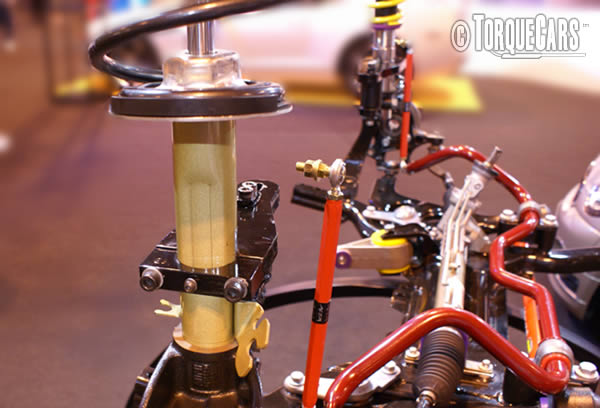Suspension tuning - lowering and stiffening.
"Shocking and absorbing stuff"
On the track your priority is fast cornering and suspension plays a large part in this. Track conditions are quite forgiving and you can make some compromises like using hard suspension and lowering the car for optimum aerodynamics and a low centre of gravity.
This works well because tracks are fairly flat and you do not have a carrier bag full of eggs in the car from your return trip to the supermarket. So what factors do you have to take into account when setting up and choosing your cars suspension if it is also used as your daily driver.

Manufacturers have to take speed bumps, uneven road surfaces, passenger comfort and road noise into consideration when setting up a cars suspension. Most production cars have a soft comfortable suspension that does little to maximise handling and driving experience.
Track cars are set up for driver preference and style so the perfect setting is not just different for each model of car it is also a subjective thing and the track characteristics are taken into account. The aim of a good suspension system is to keep the tyres on the road at the best angle to create the largest possible contact area. Body roll needs to be minimised and the cars center of gravity should be as low as possible.
Common mistakes. Going into the local part store and buying a non adjustable suspension kit that lowers the car 30mm and expecting this to be the perfect set up. Most kits are very general in nature and sometimes the suppliers imply that they can be fitted to all or many models in a cars range. Different engine weights, wheel sizes and car weights need different suspension characteristics so this one fits all approach is very misleading.
If you go too low you also risk damaging the drive shaft and gearbox if the angle from the final drive to wheel hub is wrong. The way the suspension moves under load is also altered if you change the ride height and this can cause scrubbing or premature wear on your rubber!
It is also a mistake to buy lowered springs and fit them to standard dampers or get uprated dampers and then apply them to standard springs. The entire suspension system should be viewed as a complete unit and parts matched up.

Ride Height adjustments.
Cars look good when slammed to the ground. But you reduce your ground clearance and can cause problems with tyres rubbing in the wheel arches and speed bumps can become insurmountable obstacles.
Remember that roads have speed bumps and, instead of slowing a lowered car down, they will grab the sump and rip off the bottom of the engine and most of your front skirt. Lower does not automatically mean better handling.
For most road cars TorqueCars would not recommend going lower than 35mm, and for hot hatches which tend to have uprated suspension we recommend just a 30mm drop. If you have changed the wheel size then these tolerances could be much lower with a car fitted with standard suspension and 17” rims would be OK but if you lower it as well you may get all manner of problems.
The aim should always be to improve handling and with the car being lower there will be less air going under the car and this can help with stability. Remember lower springs should be fitted to matched shocks.
Just cutting the springs is really bad idea – you are asking a piece of metal designed to a tolerance to work effectively with a big chunk of its structure missing. You should expect cut springs to break or shatter without warning.
Ideally you will get a suspension kit that can be easily adjusted on the car and this will enable you to tune the handling to suit your driving style. Ride height and damping force are nice adjustments to have but in competitions you will need to set the bound/rebound and other characteristics as well.
We have another article on suspension settings which deals with the many other adjustments and recommend that you also read this. Please feel free to discuss suspension issues and problems in our forum with other like minded car fanatics and mechanics!
Please Check out my YouTube channel, we're regularly adding new content...
PLEASE HELP: I NEED YOUR DONATIONS TO COVER THE COSTS OF RUNNING THIS SITE AND KEEP IT RUNNING. I do not charge you to access this website and it saves most TorqueCars readers $100's each year - but we are NON PROFIT and not even covering our costs. To keep us running PLEASE Donate here
If you liked this page please share it with your friends, drop a link to it in your favourite forum or use the bookmarking options to save it to your social media profile.
Feedback - What do You Think?
Please use our forums if you wish to ask a tuning question, and please note we do not sell parts or services, we are just an online magazine.
Help us improve, leave a suggestion or tip
Please watch this video and subscribe to my YouTube channel.

 Click to accept YouTube Cookies & Play.
Click to accept YouTube Cookies & Play.